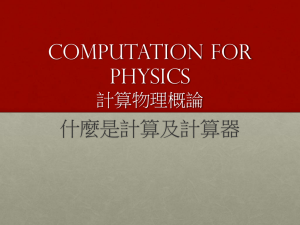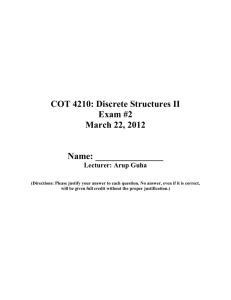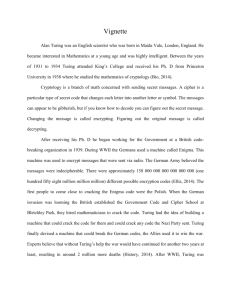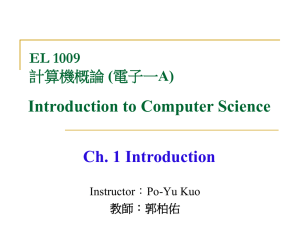CS311 / MATH352 - AUTOMATA AND COMPLEXITY THEORY
advertisement
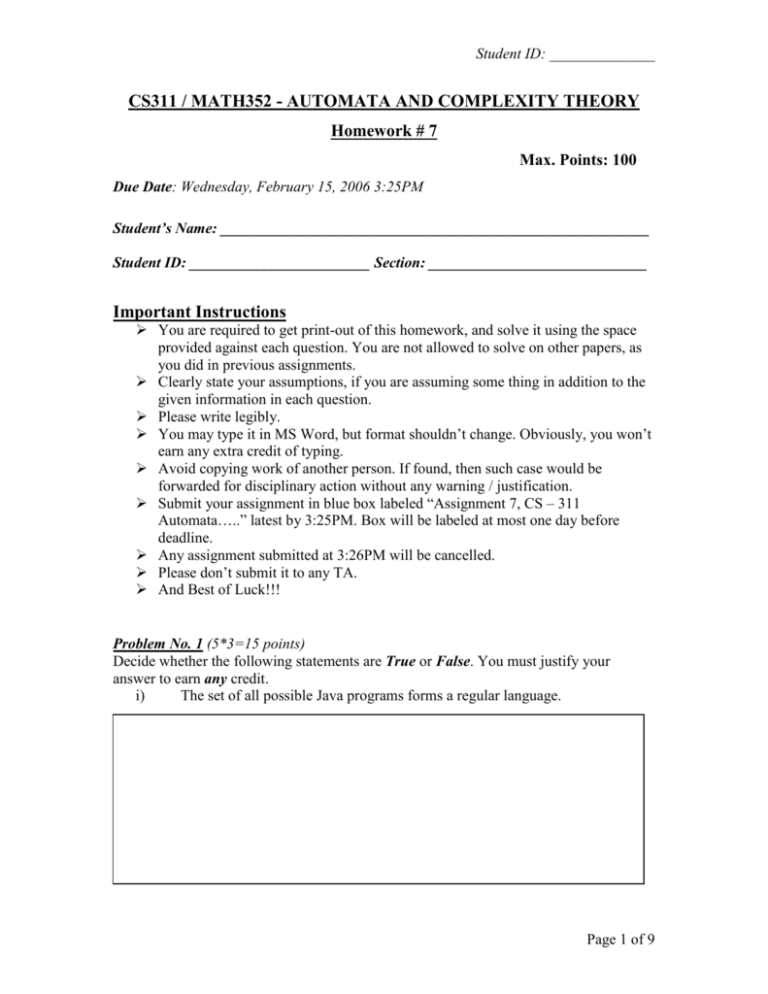
Student ID: ______________
CS311 / MATH352 - AUTOMATA AND COMPLEXITY THEORY
Homework # 7
Max. Points: 100
Due Date: Wednesday, February 15, 2006 3:25PM
Student’s Name: _________________________________________________________
Student ID: ________________________ Section: _____________________________
Important Instructions
You are required to get print-out of this homework, and solve it using the space
provided against each question. You are not allowed to solve on other papers, as
you did in previous assignments.
Clearly state your assumptions, if you are assuming some thing in addition to the
given information in each question.
Please write legibly.
You may type it in MS Word, but format shouldn’t change. Obviously, you won’t
earn any extra credit of typing.
Avoid copying work of another person. If found, then such case would be
forwarded for disciplinary action without any warning / justification.
Submit your assignment in blue box labeled “Assignment 7, CS – 311
Automata…..” latest by 3:25PM. Box will be labeled at most one day before
deadline.
Any assignment submitted at 3:26PM will be cancelled.
Please don’t submit it to any TA.
And Best of Luck!!!
Problem No. 1 (5*3=15 points)
Decide whether the following statements are True or False. You must justify your
answer to earn any credit.
i)
The set of all possible Java programs forms a regular language.
Page 1 of 9
Student ID: ______________
ii)
Every ambiguous CFG can be converted into an equivalent unambiguous
CFG.
iii)
Every non-deterministic push-down automaton has an equivalent
deterministic push-down automaton.
iv)
Every non-deterministic Turing machine has an equivalent deterministic
Turing machine.
Page 2 of 9
Student ID: ______________
v)
Every Turing machine can be simulated by a PDA with two stacks.
Problem No. 2 (5*3=15 points)
Examine the formal definition and other relevant literature of Turing machine to answer
the following questions. You must justify your answer to earn any credit. Just Yes / No
will give you no credit.
a) Can a Turing machine ever write blank symbol on its tape?
b) Can the tape alphabet Γ be the same as the input alphabet ∑?
Page 3 of 9
Student ID: ______________
c) Can a Turing machine’s head ever be in the same location in two successive
steps?
d) Can a Turing machine contain just a single state?
e) Can a single Turing machine simulate functionality of two different TM’s at the
same time?
Page 4 of 9
Student ID: ______________
Problem No. 3 (20 points)
Say that a write-once Turing machine is a single tape TM that can alter each tape square
at most once (including the input portion of tape). Show that this variant of Turing
machine model is equivalent to the ordinary TM model.
(Your proof may be informal, but it must be sensible)
Page 5 of 9
Student ID: ______________
Problem No. 4 (20 points)
Show that (single-tape) Turing machines that cannot write on the portion of the tape
containing the input string recognize only regular languages.
(Your proof may be informal, but it must be sensible)
Page 6 of 9
Student ID: ______________
Problem No. 5 (30 points)
a) Give state diagram, formal description and meaning of each state (single line meaning
per state) of Turing machine which decides following language L:
L = {w#w | w {0, 1}*}, ∑ = {0, 1 #}, Γ = {0, 1, #, └┘}
(8+2+5 points)
Page 7 of 9
Student ID: ______________
b) Prove that all words in L are accepted by the Turing machine suggested by you.
(5 points)
c) Prove that all words not in L are rejected by the Turing machine suggested by you.
(5 points)
Page 8 of 9
Student ID: ______________
d) Give the sequence of configurations that the above Turing machine enters when started
on the following input strings:
(2+3 points)
i) 01#
ii) 101#101
Page 9 of 9



